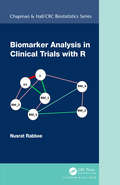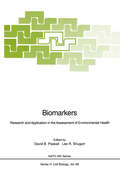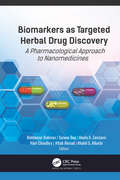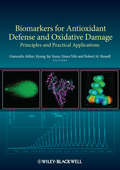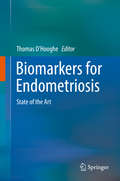- Table View
- List View
Biomarker Analysis in Clinical Trials with R (Chapman & Hall/CRC Biostatistics Series)
by Nusrat RabbeeThe world is awash in data. This volume of data will continue to increase. In the pharmaceutical industry, much of this data explosion has happened around biomarker data. Great statisticians are needed to derive understanding from these data. This book will guide you as you begin the journey into communicating, understanding and synthesizing biomarker data. -From the Foreword, Jared Christensen, Vice President, Biostatistics Early Clinical Development, Pfizer, Inc. Biomarker Analysis in Clinical Trials with R offers practical guidance to statisticians in the pharmaceutical industry on how to incorporate biomarker data analysis in clinical trial studies. The book discusses the appropriate statistical methods for evaluating pharmacodynamic, predictive and surrogate biomarkers for delivering increased value in the drug development process. The topic of combining multiple biomarkers to predict drug response using machine learning is covered. Featuring copious reproducible code and examples in R, the book helps students, researchers and biostatisticians get started in tackling the hard problems of designing and analyzing trials with biomarkers. Features: Analysis of pharmacodynamic biomarkers for lending evidence target modulation. Design and analysis of trials with a predictive biomarker. Framework for analyzing surrogate biomarkers. Methods for combining multiple biomarkers to predict treatment response. Offers a biomarker statistical analysis plan. R code, data and models are given for each part: including regression models for survival and longitudinal data, as well as statistical learning models, such as graphical models and penalized regression models. Nusrat Rabbee is a biostatistician and data scientist at Rabbee & Associates, where she creates innovative solutions to help companies accelerate drug and diagnostic development for patients. Her research interest lies in the intersection of data science and personalized medicine. She has extensive experience in bioinformatics, clinical statistics and high-dimensional data analyses. She has co-discovered the RLMM algorithm for genotyping Affymetrix SNP chips and co-invented a high-dimensional molecular signature for cancer. She has spent over 17 years in the pharmaceutical and diagnostics industry focusing on biomarker development. She has taught statistics at UC Berkeley for 4 years.
Biomarker Analysis in Clinical Trials with R (Chapman & Hall/CRC Biostatistics Series)
by Nusrat RabbeeThe world is awash in data. This volume of data will continue to increase. In the pharmaceutical industry, much of this data explosion has happened around biomarker data. Great statisticians are needed to derive understanding from these data. This book will guide you as you begin the journey into communicating, understanding and synthesizing biomarker data. -From the Foreword, Jared Christensen, Vice President, Biostatistics Early Clinical Development, Pfizer, Inc. Biomarker Analysis in Clinical Trials with R offers practical guidance to statisticians in the pharmaceutical industry on how to incorporate biomarker data analysis in clinical trial studies. The book discusses the appropriate statistical methods for evaluating pharmacodynamic, predictive and surrogate biomarkers for delivering increased value in the drug development process. The topic of combining multiple biomarkers to predict drug response using machine learning is covered. Featuring copious reproducible code and examples in R, the book helps students, researchers and biostatisticians get started in tackling the hard problems of designing and analyzing trials with biomarkers. Features: Analysis of pharmacodynamic biomarkers for lending evidence target modulation. Design and analysis of trials with a predictive biomarker. Framework for analyzing surrogate biomarkers. Methods for combining multiple biomarkers to predict treatment response. Offers a biomarker statistical analysis plan. R code, data and models are given for each part: including regression models for survival and longitudinal data, as well as statistical learning models, such as graphical models and penalized regression models. Nusrat Rabbee is a biostatistician and data scientist at Rabbee & Associates, where she creates innovative solutions to help companies accelerate drug and diagnostic development for patients. Her research interest lies in the intersection of data science and personalized medicine. She has extensive experience in bioinformatics, clinical statistics and high-dimensional data analyses. She has co-discovered the RLMM algorithm for genotyping Affymetrix SNP chips and co-invented a high-dimensional molecular signature for cancer. She has spent over 17 years in the pharmaceutical and diagnostics industry focusing on biomarker development. She has taught statistics at UC Berkeley for 4 years.
Biomarker Discovery in the Developing World: Dissecting the Pipeline for Meeting the Challenges
by Sanjeeva SrivastavaThis book is oriented towards post-graduates and researchers with interest in proteomics and its applications in clinical biomarker discovery pipeline. Biomarker discovery has long been the research focus of many life scientists globally. However, the pipeline starting from discovery to validation to regulation as a diagnostic or therapeutic molecule follows a complex trajectory. This book aims to provide an in-depth synopsis on each of these developmental phases attendant to biomarker “life cycle” with emphasis on the emerging and significant role of proteomics. The book begins with a perspective on the role of biorepositories and need for biobanking practices in the developing world. The next chapter focuses on disease heterogeneity in context to geographical bias towards susceptibility to the disease and the role of multi-omics techniques to devise disruptive innovations towards biomarker discovery. Chapter 3 focuses on various omics-based platforms that are currently being used for biomarker discovery, their principles and workflow. Mass spectrometry is emerging as a powerful technology for discovery based studies and targeted validation. Chapter 4 aims at providing a glimpse of the basic workflow and considerations in mass spectrometry based studies. Rapid and aptly targeted research funding has often been deemed as one of the decisive factors enabling excellent science and path breaking innovations. With the need for sophistication required in multi-omics research, Chapter 5 focuses on innovative funding strategies such as crowdfunding and Angel philanthropy. Chapter 6 provides the latest advances in education innovation, the premise and reality of bioeconomy especially in a specific context of the developing world, not to mention the new concept of “social innovation” to link biomarkers with socially responsible and sustainable applications. Chapter 7, in ways similar to biomarkers, discusses the biosimilars as a field that has received much focus and prominence recently due to their immense potential in clinical and pharmaceutical innovation literatures. The broader goal post-biomarker discovery is to translate their use in clinics. However, the road from bench-to-bed side is arduous and complex that is subject to oversight from various national and international regulatory bodies. Chapter 8 underscores these regulatory science considerations and provides a concise overview on intellectual property rights in biomarker discovery. Thus, this book contributed by eminent biomarker scientists, clinicians, translational researchers and social scientists holistically covers the various facets of the biomarker discovery journey from “cell to society” in developing world. The lessons learned and highlighted here are of interest to the life sciences community in a global and interdependent world.
Biomarker Methods in Drug Discovery and Development (Methods in Pharmacology and Toxicology)
by Feng WangIn this book, expert researchers provide a tool box for those who have a general interest in biomarker research and for those currently specializing in certain technologies but desiring an understanding of other available methodologies. Its chapters include validated, mature methods as well as new, incredibly promising protocols. This book is the perfect biomarker technical guideline and reference to stimulate more exciting biomarker research and technology development.
Biomarkers: Research and Application in the Assessment of Environmental Health (Nato ASI Subseries H: #68)
by David B. Peakall Lee R. ShugartBiological markers used to assess the effects of environmental pollution have attracted considerable attention from regulatory agencies and are currently under evaluation at a number of research facilities throughout the world. However promising a biomarker-based biomonitoring approach may be, the development of this concept is complicated by a range of technical issues. This book provides a conceptional framework for research and application of biomarkers. International experts on biomonitoring have formulated a unified strategy for the development and validation of biomarkers in assessing environmental health as well as appropriate protocols for their implementation and interpretation in a biological monitoring program.
Biomarkers and Biosensors for Cervical Cancer Diagnosis
by John Bosco Balaguru Rayappan Jung Heon LeeThis book highlights both conventional and nanomaterials-based biosensors for the detection of cervical cancers. It describes developments in the selective and sensitive electrochemical biosensors based on DNA for the early diagnosis of cervical cancer. Further, this book covers other nano-biosensing systems such as nano-thermometry-based sensing platforms, mechanical sensing platforms encompassing piezoelectric-based sensors, electrochemical impedance spectroscopy based on PEGylated arginine functionalized magnetic nanoparticles, and field-effect transistor-based platforms for the early detection of cervical cancer. Also, it presents conventional platforms such as vibrational spectroscopy and polymerase chain reaction techniques for the diagnosis of cervical cancer. Finally, it reviews currently available biomarkers for the early diagnosis of cervical cancer and presents strategies for developing novel biomarkers based on cellular and molecular approaches. As such, this book is a comprehensive resource for researchers and clinicians working in cervical cancer diagnostics.
Biomarkers and Mental Illness: It’s Not All in the Mind
by Paul C. GuestEmploying accessible language throughout, this book covers the history of psychiatric research, the current state-of-the art in psychiatric practice, the physiological systems affected by psychiatric illnesses, the whole-body nature of these diseases and the impact that this aspect has on emerging biomarker discoveries. Further, it provides descriptions of the major specific psychiatric disorders and the special challenges regarding the diagnosis and treatment of each. The book concludes with insights into the latest developments in hand-held biomarker test devices, which can provide diagnostic information in less than 15 minutes in point-of-care settings.This book investigates the emerging use of biomarkers in the study of psychiatric diseases, a topic of considerable importance for a broad range of people including researchers, clinicians, psychiatrists, university students and even those whose lives are affected in some way by a psychiatric illness. The last category is hardly trivial, since a staggering one in three people worldwide show the criteria for at least one psychiatric disorder at some point in their lifetime.
Biomarkers as Targeted Herbal Drug Discovery: A Pharmacological Approach to Nanomedicines
by Aftab Ahmad Hani Choudhry Sarwar Beg Mahfoozur Rahman Mazin A. Zamzami Khalid S. AlharbiThis new volume looks at the applications of biomarkers as important tools for herbal drug discovery, presenting research on phytoconstituents with advanced nanotechnological applications for healthcare benefits. Herbal drug discovery based on biomarkers is an emerging area in complementary and alternative medicine that has tremendous potential in healthcare. Conventional medications have limited efficacy and high toxicity, whereas herbal drugs are said to provide wide structural diversity that is not usually seen with conventional/synthetic drug molecules. Recognition of various herbal constituents, such as terpenoids, fatty acids, flavonoids and steroids, are well explored in the management and treatment of various disorders in this volume. These agents target various biomarkers such as nitric oxide (NO), cytokines, chemokines, adhesion molecules, NF- kβ, lipoxygenase (LOX), and arachidonic acid. Biomarkers as Targeted Herbal Drug Discovery: A Pharmacological Approach to Nanomedicines discusses phytoconstituent-based nanotherapeutics with applications for some specific health issues, such as arthritis, leishmanicidal, cardiovascular diseases, cancer, ocular disorders, etc.
Biomarkers as Targeted Herbal Drug Discovery: A Pharmacological Approach to Nanomedicines
by Mahfoozur RahmanThis new volume looks at the applications of biomarkers as important tools for herbal drug discovery, presenting research on phytoconstituents with advanced nanotechnological applications for healthcare benefits. Herbal drug discovery based on biomarkers is an emerging area in complementary and alternative medicine that has tremendous potential in healthcare. Conventional medications have limited efficacy and high toxicity, whereas herbal drugs are said to provide wide structural diversity that is not usually seen with conventional/synthetic drug molecules. Recognition of various herbal constituents, such as terpenoids, fatty acids, flavonoids and steroids, are well explored in the management and treatment of various disorders in this volume. These agents target various biomarkers such as nitric oxide (NO), cytokines, chemokines, adhesion molecules, NF- kβ, lipoxygenase (LOX), and arachidonic acid. Biomarkers as Targeted Herbal Drug Discovery: A Pharmacological Approach to Nanomedicines discusses phytoconstituent-based nanotherapeutics with applications for some specific health issues, such as arthritis, leishmanicidal, cardiovascular diseases, cancer, ocular disorders, etc.
Biomarkers for Alzheimer’s Disease Drug Development (Methods in Molecular Biology #1750)
by Robert PerneczkyThis volume aims to build a new generation of experts with a broader understanding of key topics in the Alzheimer’s disease field. Chapters guide readers through innovative approaches to the discovery of novel biomarkers in cerebrospinal fluid, innovation in blood-based biomarkers, a comprehensive overview of magnetic resonance imaging and molecular imaging approaches and their value for developing drugs for Alzheimer’s disease, cutting-edge developments in neuropathology and their relevance for Alzheimer’s disease trials, novel genomic strategies for biomarker development, and related topics including neuropsychological testing and advanced analytical methods.Written in the highly successful Methods in Molecular Biology series format, chapters include introductions to their respective topics, lists of the necessary materials and reagents, step-by-step, readily reproducible laboratory protocols, and tips on troubleshooting and avoiding known pitfalls. Authoritative and cutting-edge, Biomarkers for Alzheimer's Disease Drug Development aims to ensure successful results in the further study of this vital field.
Biomarkers for Alzheimer’s Disease Drug Development (Methods In Molecular Biology Ser. #1750)
by Robert PerneczkyBiomarkers for Alzheimer’s Disease Drug Development (Methods in Molecular Biology #2785)
by Robert PerneczkyThis fully updated volume provides an up-to-date and comprehensive overview of the current state of technologies helping to accelerate Alzheimer’s disease drug development. Addressing the latest advances in preclinical and clinical research, including new insights into the molecular mechanisms and emerging therapeutic strategies, the book continues by exploring digital biomarkers and advanced neuroimaging analysis which will transform how clinical trials in the Alzheimer’s disease field are performed. Written for the highly successful Methods in Molecular Biology series, chapters feature the kind of detailed implementation advice that leads to greater success in the lab or clinic. Authoritative and practical, Biomarkers for Alzheimer’s Disease Drug Development, Second Edition seeks to inspire and inform future efforts to develop effective treatments for this devastating disease.
Biomarkers for Antioxidant Defense and Oxidative Damage: Principles and Practical Applications
by Giancarlo Aldini Kyung-Jin Yeum Etsuo Niki Robert M. RussellBiomarkers for Antioxidant Defense and Oxidative Damage: Principles and Practical Applications critically evaluates the basic concepts and methodologies of conventional biomarkers as well as current state-of-the-art assays for measuring antioxidant activity/oxidative stress and their practical applications. . Biomarkers for Antioxidant Defense and Oxidative Damage: Principles and Practical Applications will be of a great interest to scientists who are involved in basic research on oxidation, applied scientists evaluating the effects of nutraceuticals or pharmaceutical compounds on antioxidant activity/oxidative stress, and physicians who want to understand the degree of oxidative damage in patients with certain chronic diseases. Discovering sensitive and specific biomarkers for systemic oxidative damage is essential to understand the role of oxidative stress in human disease. Once these roles are clearly understood, we are able to identify novel drug and nutraceutical targets. This volume goes beyond conventional analytical methods of measuring overall antioxidant activity and provides insight to the discovery of biomarkers that reveal information on specific areas of oxidative stress. Contributed by an international list of experts, Biomarkers for Antioxidant Defense and Oxidative Damage: Principles and Practical Applications describes both conventional biomarkers and recent developments in this area. Special Features: Discusses conventional biomarkers as well as recent advances for measuring antioxidants and oxidative stress Biomarkers for lipid peroxidation: isoprostane, hydroxyloctadecaenoic acid, oxysterols, and reactive carbonyl species from lipid peroxidation Biomarkers for protein oxidation: carbonylation, tyrosine oxidation, ubiquitin-conjugation Biomarkers for DNA oxidative damage: comet assay, hydroxylated nucleotides, and exocylcic DNA adducts Recently developed biomarkers from cutting-edge technology
Biomarkers for Antioxidant Defense and Oxidative Damage: Principles and Practical Applications
by Giancarlo Aldini Kyung-Jin Yeum Etsuo Niki Robert M. RussellBiomarkers for Antioxidant Defense and Oxidative Damage: Principles and Practical Applications critically evaluates the basic concepts and methodologies of conventional biomarkers as well as current state-of-the-art assays for measuring antioxidant activity/oxidative stress and their practical applications. . Biomarkers for Antioxidant Defense and Oxidative Damage: Principles and Practical Applications will be of a great interest to scientists who are involved in basic research on oxidation, applied scientists evaluating the effects of nutraceuticals or pharmaceutical compounds on antioxidant activity/oxidative stress, and physicians who want to understand the degree of oxidative damage in patients with certain chronic diseases. Discovering sensitive and specific biomarkers for systemic oxidative damage is essential to understand the role of oxidative stress in human disease. Once these roles are clearly understood, we are able to identify novel drug and nutraceutical targets. This volume goes beyond conventional analytical methods of measuring overall antioxidant activity and provides insight to the discovery of biomarkers that reveal information on specific areas of oxidative stress. Contributed by an international list of experts, Biomarkers for Antioxidant Defense and Oxidative Damage: Principles and Practical Applications describes both conventional biomarkers and recent developments in this area. Special Features: Discusses conventional biomarkers as well as recent advances for measuring antioxidants and oxidative stress Biomarkers for lipid peroxidation: isoprostane, hydroxyloctadecaenoic acid, oxysterols, and reactive carbonyl species from lipid peroxidation Biomarkers for protein oxidation: carbonylation, tyrosine oxidation, ubiquitin-conjugation Biomarkers for DNA oxidative damage: comet assay, hydroxylated nucleotides, and exocylcic DNA adducts Recently developed biomarkers from cutting-edge technology
Biomarkers for Endometriosis: State of the Art
by Thomas D'HoogheThis book presents an overview of the diagnostic performance of non- or semi-invasive tests for endometriosis in peripheral blood, endometrium, saliva, peritoneal fluid and urine. The value of existing and emerging systems biology technologies for biomarker development is addressed in several chapters on genetics, microarrays, proteomics and metabolomics. Although tests with high sensitivity and acceptable specificity have been developed, sometimes validated in independent populations and seem promising, more research is needed to translate these data into clinical benefit for patients and coordinate efforts internationally to standarize analysis, reports and operating procedures. The gold standard to diagnose endometriosis is currently through laparoscopic inspection with histological confirmation, a surgical procedure with rare but significant potential risks for the patients. A non-invasive test for endometriosis would be critical for the early detection of endometriosis of symptomatic women with pelvic pain and/or subfertility with normal ultrasound. This would include nearly all cases of minimal-mild endometriosis, some cases of moderate-severe endometriosis without a clearly visible ovarian endometrioma and cases with pelvic adhesions and/or other pelvic pathology, who might benefit from surgery to improve pelvic pain and/or subfertility. Such a test would also be useful in symptomatic women with ultrasound imaging suspicious for endometriosis, since it may be difficult to differentiate an ovarian endometrioma from other ovarian cysts and since the quality of ultrasound imaging is highly variable worldwide.
Biomarkers for Huntington's Disease: Improving Clinical Outcomes (Contemporary Clinical Neuroscience)
by Elizabeth A. Thomas Georgia M. ParkinHuntington’s disease (HD) is a fatal, inherited, neurodegenerative disorder, characterized by chorea, motor instabilities, psychiatric manifestations and cognitive decline. Early genetic testing provides an opportunity for clinical interventions aimed at delaying onset and/or slowing progression of disease; however, current treatments for HD are limited, with only two FDA-approved drugs available to manage chorea. Encouragingly, however, several disease-modifying treatment approaches are in the therapeutic pipeline, with more than 200 clinical studies, and many more preclinical studies, in the works. Robust and reliable biomarkers are needed to predict disease onset, monitor disease progression and assess treatment responses. More specifically, biomarkers to stratify patients for clinical trials and biomarkers to track drug efficacy will certainly lead to improved clinical trial design and success. This book represents the first book focused solely on biomarkers for HD and represents a distinct resource that will be informative, not only for clinicians and those involved in clinical trial design, but also for a wide range of neurodegenerative disease researchers. This edited volume is written by top leaders in the field, and takes a cross-disciplinary approach to cover a broad spectrum of biomarker types, in order to provide the latest advances in the development of biochemical, molecular, imaging and digital biomarkers that have been investigated for HD. With the ultimate goal of treating patients, the development of disease-associated biomarkers has never been more important.
Biomarkers for Immunotherapy of Cancer: Methods and Protocols (Methods in Molecular Biology #2055)
by Magdalena Thurin Alessandra Cesano Francesco M. MarincolaThis book provides the immune oncology (IO) community with a deeper understanding of the scope of the biomarker methods to potentially improve the outcome from immunotherapy. The editors secured the input from experts in the field dedicated to translating scientific research from bench to bedside was submitted. The book provides not only details about the technical, standardization and interpretation aspects of the methods but also introduces the reader to the background information and scientific justification for selected biomarkers and assays. Written in the highly successful Methods in Molecular Biology series format, chapters include introductions to their respective topics, lists of the necessary materials and reagents, step-by-step, readily reproducible laboratory protocols, and tips on troubleshooting and avoiding known pitfalls.
Biomarkers for Preclinical Alzheimer’s Disease (Neuromethods #137)
by Robert PerneczkyThis volume discusses the importance of imaging, fluid, and genetic biomarkers in detecting the earliest pre-symptomatic stages of Alzheimer’s disease (AD). The chapters in this book are separated into five parts. Part one explores the reasons why we need improved approaches for early detection and diagnosis of AD. Part two describes clinical and research techniques for preclinical AD diagnosis. Part three looks at the current methods in use to diagnose AD and how they can also be used for early detection in healthy older individuals. Parts four and five talk about technological advancements in AD diagnosis and ethical considerations in AD research. In Neuromethods series style, chapters include the kind of detail and key advice from the specialists needed to get successful results in your laboratory.Comprehensive and cutting-edge, Biomarkers for Preclinical Alzheimer’s Disease is a valuable resource for individuals interested in the use of biomarker strategies to improve early AD detection. This book will be of great interest to researchers and clinicians from both academia and industry.”
Biomarkers for Psychiatric Disorders
by Christoph W. TurckBiomarkers hold immense promise for the early detection of disease. Unlike other disorders like diabetes and heart disease where a limited number of biological markers are at hand that allow the physician to come up with a reliable diagnosis, there are currently no such markers available for affective disorders. As in any other disease area a major goal is therefore the identification of early markers that can categorize subsets of subjects in a consistent manner. This will allow a more precise definition and categorization of affective disorders and in turn facilitate investigations of the pathogenesis of the diseases and enhance our ability for treatment. This edited volume will not only address the area of affective disorders but also other brain disorders that are neurological in nature, including Multiple Sclerosis and Alzheimer Disease.
Biomarkers for Traumatic Brain Injury
by W. Frank Peacock Alan H. B. WuBiomarkers for Traumatic Brain Injury provides a comprehensive overview on the selection and implementation of serum-based and saliva-based biomarkers for traumatic brain injury. The book presents an economic analysis for implementing TBI biomarkers into clinical practice. In addition, it discusses the analytical tools needed to implement TBI biomarkers, including specifications for testing instruments and interpretative software. Neurologists, emergency department physicians, intensivists, and clinical laboratorians will find this book a great resource from which to familiarize themselves with the issues and processes regarding TBI biomarkers. Approximately 2 million people in the U.S. sustain a traumatic brain injury (TBI) each year with over 250,000 hospitalizations and 50,000 deaths. There has been a significant rise in interest in diagnosing mild concussions, particularly in the sports world. While imaging has been the gold standard, these procedures are costly and not always available. There is great potential in using serum-based biomarkers, hence the book seeks to enlighten readers on new possibilities. Offers strategies for the selection and implementation of traumatic brain injury biomarkersDiscusses the importance of autoantibodies and post translational modifications for TBICovers the analytical tools needed to implement TBI biomarkers, including the specifications for testing instruments and interpretative software
Biomarkers in Alzheimer's Disease
by Tapan KhanBiomarkers in Alzheimer’s Disease provides a comprehensive overview of all modalities of Alzheimer’s disease biomarkers, including neuroimaging, cerebrospinal fluid, genomic, and peripheral systems. Each chapter integrates molecular/cellular abnormality due to Alzheimer’s disease and technological advancement of biomarkers techniques. The book is ideal for clinical neuroscience and molecular/cellular neuroscience researchers, psychiatrists, and allied healthcare practitioners involved in the diagnosis and management of patients with cognitive impairment and Alzheimer’s disease, and for differential diagnosis of Alzheimer’s disease with other non-Alzheimer’s dementia.Presents a comprehensive overview detailing all modalities of Alzheimer’s disease biomarkersWritten for neuroscience researchers and clinicians studying or treating patients with Alzheimer’s DiseaseIntegrates, in each chapter, the molecular/cellular abnormality due to Alzheimer’s disease and the technological advancement of biomarkers techniques
Biomarkers in Breast Cancer (Cancer Drug Discovery and Development)
by Giampietro Gasparini Daniel F. HayesExpert laboratory and clinical researchers from around the world review how to design and evaluate studies of tumor markers and examine their use in breast cancer patients. The authors cover both the major advances in sophisticated molecular methods and the state-of-the-art in conventional prognostic and predictive indicators. Among the topics discussed are the relevance of rigorous study design and guidelines for the validation studies of new biomarkers, gene expression profiling by tissue microarrays, adjuvant systemic therapy, and the use of estrogen, progesterone, and epidermal growth factor receptors as both prognostic and predictive indicators. Highlights include the evaluation of HER2 and EGFR family members, of p53, and of UPA/PAI-1; the detection of rare cells in blood and marrow; and the detection and analysis of soluble, circulating markers.
Biomarkers in Cancer Screening and Early Detection (Translational Oncology #3)
by Sudhir SrivastavaPrepared by world leaders on this topic, Biomarkers in Cancer Screening and Early Detection offers a comprehensive, state-of-the-art perspective on the various research and clinical aspects of cancer biomarkers, from their discovery and development to their validation, clinical utility, and use in developing personalized cancer treatment. Offers a comprehensive, state-of-the-art perspective on the various research and clinical aspects of cancer biomarkers Provides immediately actionable information – and hopefully also inspiration – to move discovery and clinical application forward Offers vital knowledge to help develop personalized cancer treatment for individual patients with specific cancers
Biomarkers in Cancer Screening and Early Detection (Translational Oncology)
by Sudhir SrivastavaPrepared by world leaders on this topic, Biomarkers in Cancer Screening and Early Detection offers a comprehensive, state-of-the-art perspective on the various research and clinical aspects of cancer biomarkers, from their discovery and development to their validation, clinical utility, and use in developing personalized cancer treatment. Offers a comprehensive, state-of-the-art perspective on the various research and clinical aspects of cancer biomarkers Provides immediately actionable information – and hopefully also inspiration – to move discovery and clinical application forward Offers vital knowledge to help develop personalized cancer treatment for individual patients with specific cancers
